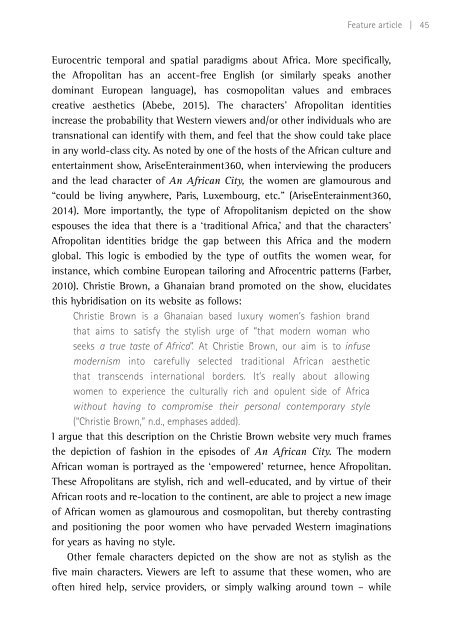The politics of fashion and beauty in Africa
fa21_proof_3
fa21_proof_3
Create successful ePaper yourself
Turn your PDF publications into a flip-book with our unique Google optimized e-Paper software.
Feature article | 45<br />
Eurocentric temporal <strong>and</strong> spatial paradigms about <strong>Africa</strong>. More specifically,<br />
the Afropolitan has an accent-free English (or similarly speaks another<br />
dom<strong>in</strong>ant European language), has cosmopolitan values <strong>and</strong> embraces<br />
creative aesthetics (Abebe, 2015). <strong>The</strong> characters’ Afropolitan identities<br />
<strong>in</strong>crease the probability that Western viewers <strong>and</strong>/or other <strong>in</strong>dividuals who are<br />
transnational can identify with them, <strong>and</strong> feel that the show could take place<br />
<strong>in</strong> any world-class city. As noted by one <strong>of</strong> the hosts <strong>of</strong> the <strong>Africa</strong>n culture <strong>and</strong><br />
enterta<strong>in</strong>ment show, AriseEntera<strong>in</strong>ment360, when <strong>in</strong>terview<strong>in</strong>g the producers<br />
<strong>and</strong> the lead character <strong>of</strong> An <strong>Africa</strong>n City, the women are glamourous <strong>and</strong><br />
“could be liv<strong>in</strong>g anywhere, Paris, Luxembourg, etc.” (AriseEntera<strong>in</strong>ment360,<br />
2014). More importantly, the type <strong>of</strong> Afropolitanism depicted on the show<br />
espouses the idea that there is a ‘traditional <strong>Africa</strong>,’ <strong>and</strong> that the characters’<br />
Afropolitan identities bridge the gap between this <strong>Africa</strong> <strong>and</strong> the modern<br />
global. This logic is embodied by the type <strong>of</strong> outfits the women wear, for<br />
<strong>in</strong>stance, which comb<strong>in</strong>e European tailor<strong>in</strong>g <strong>and</strong> Afrocentric patterns (Farber,<br />
2010). Christie Brown, a Ghanaian br<strong>and</strong> promoted on the show, elucidates<br />
this hybridisation on its website as follows:<br />
Christie Brown is a Ghanaian based luxury women’s <strong>fashion</strong> br<strong>and</strong><br />
that aims to satisfy the stylish urge <strong>of</strong> “that modern woman who<br />
seeks a true taste <strong>of</strong> <strong>Africa</strong>”. At Christie Brown, our aim is to <strong>in</strong>fuse<br />
modernism <strong>in</strong>to carefully selected traditional <strong>Africa</strong>n aesthetic<br />
that transcends <strong>in</strong>ternational borders. It’s really about allow<strong>in</strong>g<br />
women to experience the culturally rich <strong>and</strong> opulent side <strong>of</strong> <strong>Africa</strong><br />
without hav<strong>in</strong>g to compromise their personal contemporary style<br />
(“Christie Brown,” n.d., emphases added).<br />
I argue that this description on the Christie Brown website very much frames<br />
the depiction <strong>of</strong> <strong>fashion</strong> <strong>in</strong> the episodes <strong>of</strong> An <strong>Africa</strong>n City. <strong>The</strong> modern<br />
<strong>Africa</strong>n woman is portrayed as the ‘empowered’ returnee, hence Afropolitan.<br />
<strong>The</strong>se Afropolitans are stylish, rich <strong>and</strong> well-educated, <strong>and</strong> by virtue <strong>of</strong> their<br />
<strong>Africa</strong>n roots <strong>and</strong> re-location to the cont<strong>in</strong>ent, are able to project a new image<br />
<strong>of</strong> <strong>Africa</strong>n women as glamourous <strong>and</strong> cosmopolitan, but thereby contrast<strong>in</strong>g<br />
<strong>and</strong> position<strong>in</strong>g the poor women who have pervaded Western imag<strong>in</strong>ations<br />
for years as hav<strong>in</strong>g no style.<br />
Other female characters depicted on the show are not as stylish as the<br />
five ma<strong>in</strong> characters. Viewers are left to assume that these women, who are<br />
<strong>of</strong>ten hired help, service providers, or simply walk<strong>in</strong>g around town – while



